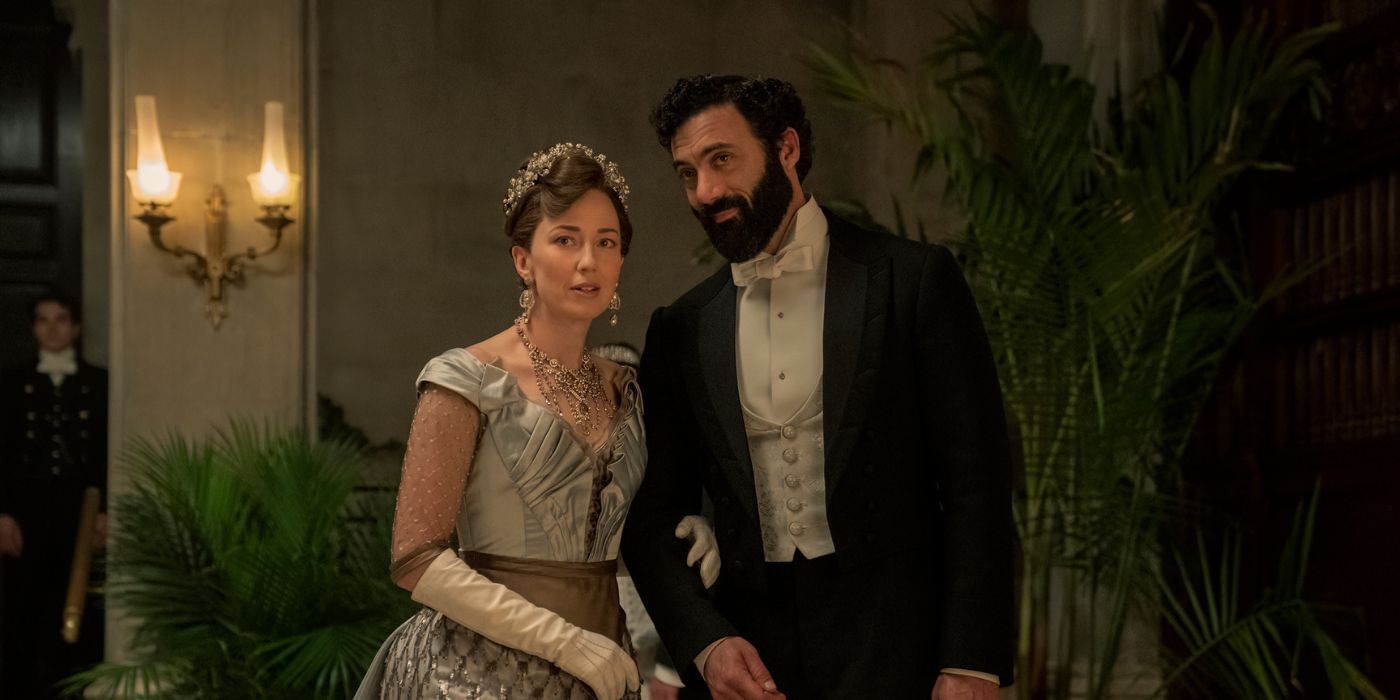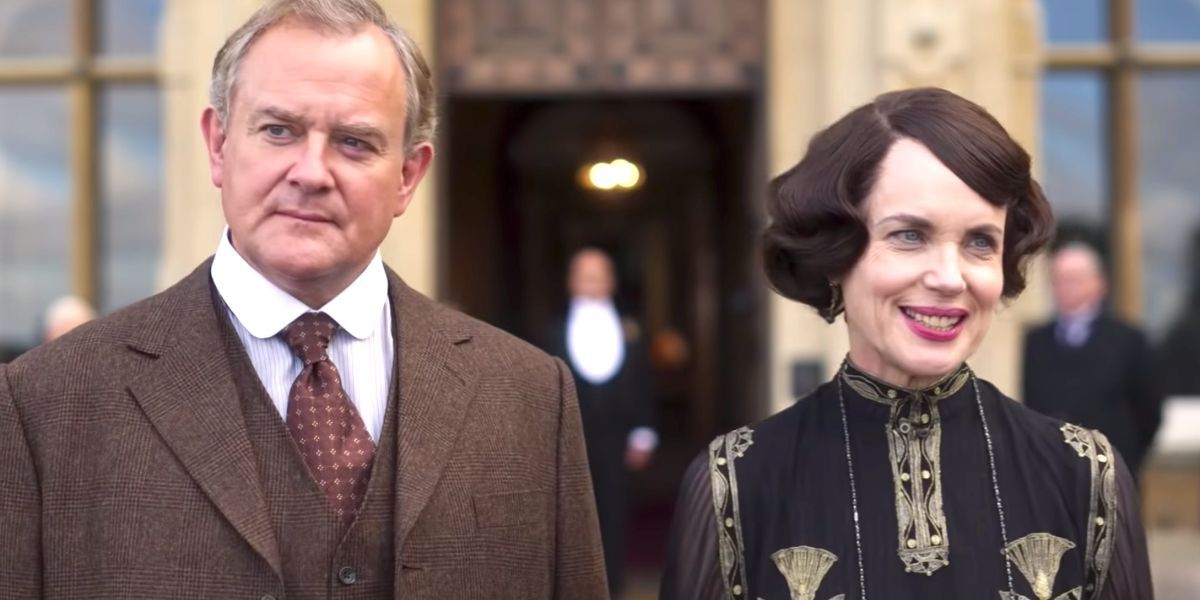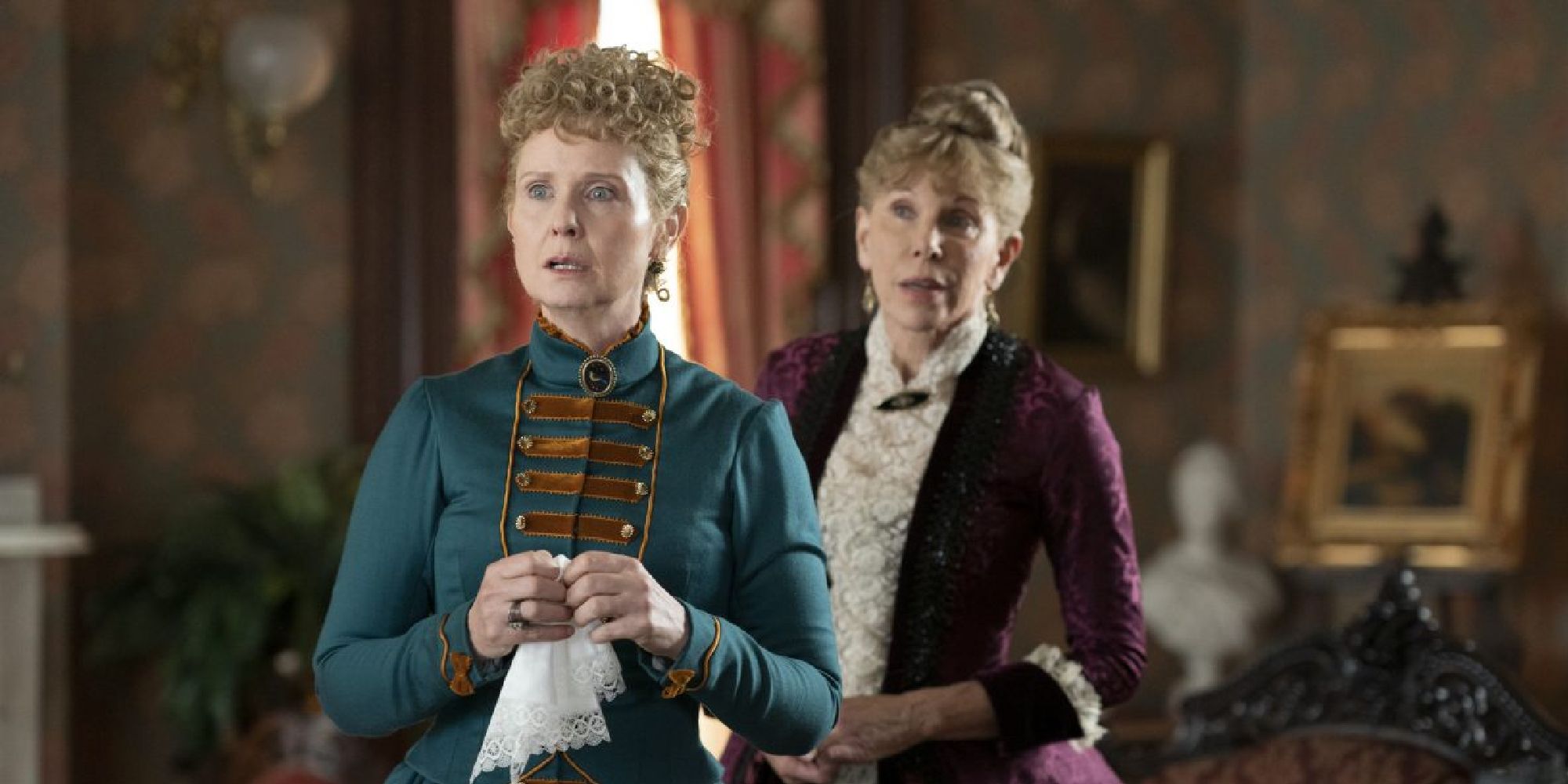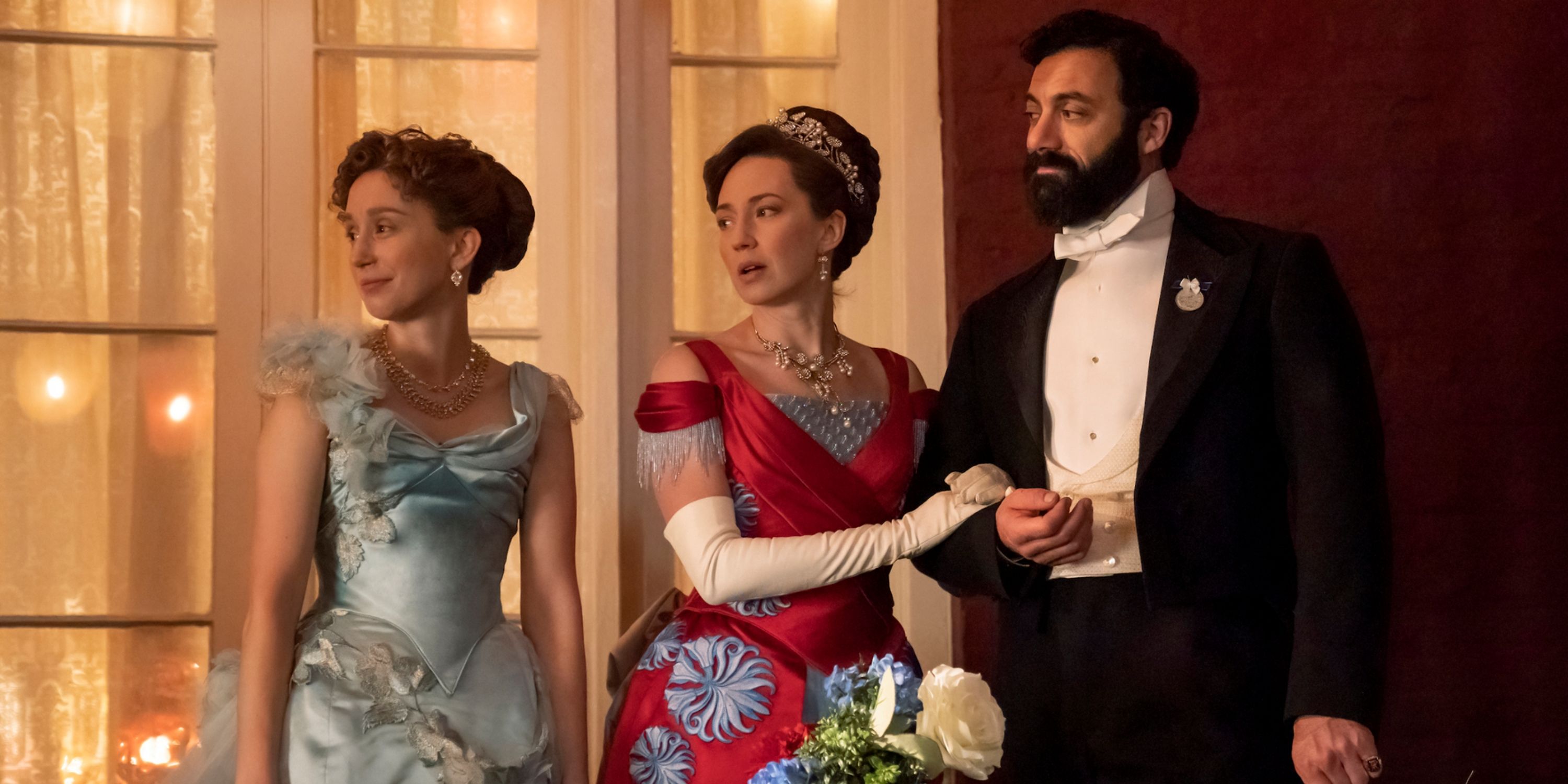Editor’s Note: The following contains spoilers for The Gilded Age Season 2, Episode 1.
The Big Picture
- The Gilded Age and Downton Abbey share more similarities than their mutual creator, Julian Fellowes, as both series explore an upper-class society in a changing world.
- The initial concept for The Gilded Age was a prequel about Cora before she married into the Crawley family, but, over time, it evolved into a separate story still set in 1880s New York City.
- The Gilded Age distinguishes itself from Downton Abbey by expanding its focus beyond a single household, to center on two distinct families rather than Downton Abbey’s singular focus on the Crawleys.
Downton Abbey is unquestioningly Julian Fellowes‘ most famous series and has since inspired the writer to work on more historical dramas. The story follows the Crawley family through the tumultuous historical events of the early twentieth century as modern changes threaten their lavish lifestyle. Eight years after its end, the show is still so beloved that Downton Abbey can now boast two sequel movies. And the story shows no signs of ending, as it is rumored to return for another season. But, interestingly, despite the show’s success and continued
marketability, it never received a spinoff series. The practice is rapidly gaining popularity, with recognizable examples such as Queen Charlotte: A Bridgerton Story and House of the Dragon expanding the worlds of Bridgerton and Game of Thrones, respectively. Yet Downton Abbey has stuck strictly to continuing the story in sequels rather than exploring smaller characters or a different time period.
Fellowes has created other historical drama series in different eras. Doctor Thorne and Belgravia both explore the lives of England’s wealthy, but neither reached the same acclaim as Downton Abbey. So it should be no surprise that Fellowes tries something different in his newest series, The Gilded Age. Taking place an ocean away from his previous works, The Gilded Age is set in 1880s New York City, making it just a few decades before Downton Abbey but a world away. Like Downton Abbey, The Gilded Age‘s story deals with the upper class as the younger generation challenged the traditional ways. Although the beloved and feared Dowager Countess, Violet Crawley (Maggie Smith), would be offended by any comparison to the American characters, the shows are similar. There is a clear distinction between the shows, but originally, they were more closely related. The concept began as a prequel series about Lord Grantham’s American wife, Cora Crawley (Elizabeth McGovern). Though the idea is no longer connected to Downton Abbey, some similarities to Cora’s past remain. Yet the wider scope of the series distinguishes it from Downton Abbey. With the two shows unconnected, The Gilded Age doesn’t have a predefined ending, so the separation works in its favor.
The Gilded Age
A wide-eyed young scion of a conservative family embarks on a mission to infiltrate the wealthy neighboring clan dominated by ruthless railroad tycoon George Russell, his rakish son, Larry, and his ambitious wife, Bertha.
- Release Date
- January 24, 2022
- Cast
- Carrie Coon, Morgan Spector, Louisa Jacobson, Denée Benton, Taissa Farmiga, Harry Richardson, Blake Ritson, Thomas Cocquerel, Simon Jones, Jack Gilpin, Cynthia Nixon, Christine Baranski, Donna Murphy, Debra Monk
- Main Genre
- Drama
What Would the ‘Downton Abbey’ Prequel Have Looked Like?
The initial idea proposed was a prequel centering on Cora when she was still Cora Levinson, but as the series developed, it pivoted into The Gilded Age. Yet the concept alone hints at what the series would have been about. Focusing on the character’s childhood in America, it would have featured a divided New York Society as the newly rich “robber barons” attempted to buy their way into the aristocratic society, much like the end result does, only with familiar characters. Downton Abbey introduces several of Cora’s family members, including her determined mother, Martha (Shirley MacLaine), and her free-spirited brother, Harold (Paul Giamatti), who surely would have appeared. The show also mentions her father, Isidore, though he never appears. Isidore is described as a shrewd businessman who amassed his fortune as a dry goods merchant. With these characters established, their story can be easily imagined.
Originally described as a coming-of-age story for the future Countess, the plot would likely have focused on her mother’s ambitious plan to gain societal legitimacy by marrying her daughter to an English Lord. One of the few things known about Cora’s youth is her journey to England in search of a husband. Driven by Martha’s scheming, Cora met the young Robert Crawley (Hugh Bonneville), who married her for the money to bail out the failing family estate. Later, the two fall in love, and Robert is ashamed of his fortune-hunting motives. A prequel about this event would be interesting to watch, as it explores a relationship that is instrumental to the original series. But with Downton Abbey detailing their life together after their daughters are grown, the audience would know the ending before the show even began.
Fortunately, that is not an issue anymore. During an extended development, the idea drastically changed into The Gilded Age. Though set in roughly the same timeframe Cora’s series would have, the story is very different. Yet there are similarities. Focusing instead on the Russells and the van Rhijns, the series portrays the events in New York City as the “new money” families clash with the long-established society that doesn’t want them. The two leading families live across the street, and though the van Rhijn matriarch, Agnes (Christine Baranski), resists the Russells’ attempts to join society, the younger generation is less opposed. The proximity and their ages put the two families in danger of joining in a Romeo-and-Juliet-type story. With original characters, the story is very different, but the influence of Downton Abbey is prevalent.
‘The Gilded Age’ Mirrors ‘Downton Abbey’
Though The Gilded Age is separate from Downton Abbey, the influence the original has on the new show is clear through the characters with similar goals to the original concept and the familiar relationships seen in the show. The Gilded Age‘s roots as a prequel about Cora are never more obvious than in the parallels with the Russell family. Representing new money, George Russell (Morgan Spector) is a railroad tycoon with an ambitious wife, Bertha (Carrie Coon), and two children. The family of four is set up much like the Levinsons, as Bertha follows Martha’s lead of attempting to affirm her position in society through a well-placed marriage for her daughter, Gladys (Taissa Farmiga). Though, in Downton Abbey, the plan worked for Martha, Bertha’s success is yet to be determined. However, it seems unlikely that she will have to travel to England to find Gladys a husband since suitors are already lining up. This comparison is deepened as Gladys is pursued by fortune hunter Oscar van Rhijn (Blake Ritson). Though his reasons are already different than Robert’s, Oscar is interested in Gladys for the money, and his much more traditional mother is against the match. However, in Gladys and Oscar’s case, Bertha is against the marriage, while Martha supports Cora and Robert’s relationship. Yet, it is easy to see how these events developed from the original idea.
The similarities between the two shows go beyond the Russell family, as other characters are reminiscent of Downton Abbey‘s beloved cast. Most significantly, Agnes van Rhijn and her sister Ada Brooks (Cynthia Nixon) bring to mind the often contentious friendship of Violet and Isobel Crawley (Penelope Wilton). Unlike Downton Abbey’s pair, Agnes and Ada are not locked in constant competition, but they have opposing opinions that neither will give up. Like Violet, Agnes is set in the old ways, while both Ada and Isobel are open to the new. Violet and Agnes also share family loyalty and a softer side that they allow few to see. Marian Brooks (Louisa Jacobson) channels Sybil Crawley (Jessica Brown Findlay) as she defies the societal norms her family wants her to follow to chase her dreams. While Sybil finds purpose in politics and working as a nurse, Marian searches for it first in charities and later in teaching, but both stand up for themselves against the disapproval of their loved ones. With such clear inspiration drawn from Downton Abbey‘s characters, it’s easy to compare the two shows.
But ‘The Gilded Age’ and ‘Downton Abbey’ Are Not the Same
Despite the similarities, The Gilded Age and Downton Abbey have some major differences. The Gilded Age takes on a life of its own by expanding the story. Unlike Downton Abbey, the series doesn’t focus on a single household but two. The Russells and the van Rhijns live near each other, but they have very different households. While Downton Abbey centers on the Crawleys and those who live in their house, The Gilded Age focuses on the ins and outs of the New York society set and spares less time for the servants, though they are ever present in the houses. Claiming one approach is better than the other is a matter of taste. However, the distinction does prove that The Gilded Age isn’t just an American Downton Abbey.
Though there is clear inspiration from Downton Abbey, The Gilded Age isn’t directly related to the other series, and that works in its favor. The creators chose what worked in the earlier show and used that to guide their story. But with no direct crossovers, The Gilded Age is not tied to anything from Downton Abbey. The series doesn’t have to concern itself with the timeline regarding Cora’s age or any other event from the other show. Without an established result, the characters’ stories can develop in unexpected ways. Though a prequel would bring a dedicated audience, it benefits The Gilded Age to have the freedom to do as it pleases. After all, George Russell’s train crash in Season 1 created a sense of urgency in the series that a sudden dry goods emergency for Isidore Levinson may have struggled to match, especially as there is no threat of him losing the money based on what is seen of his family decades later. Likewise, Downton Abbey fans know Harold remains a bachelor, losing any mystery in potential romances for the character. Despite the similarities between the two shows, The Gilded Age and Downton Abbey are different, and that is better for both. The Gilded Age remains completely free of aligning itself with Downton Abbey, and as the Crawleys’ story continues, it retains the same freedom. Though the two period dramas are likely to have an overlapping audience, it’s good that they are their own things.
The Gilded Age airs on Sunday nights on HBO and is available to stream on Max.
Denial of responsibility! TechCodex is an automatic aggregator of the all world’s media. In each content, the hyperlink to the primary source is specified. All trademarks belong to their rightful owners, and all materials to their authors. For any complaint, please reach us at – [email protected]. We will take necessary action within 24 hours.
Khushi Patel is a science fiction author who lives in Austin, Texas. She has published three novels, and her work has been praised for its originality and imagination. Khushi is a graduate of Rice University, and she has worked as a software engineer. She is a member of the Science Fiction Writers of America, and her books have been nominated for several awards.





